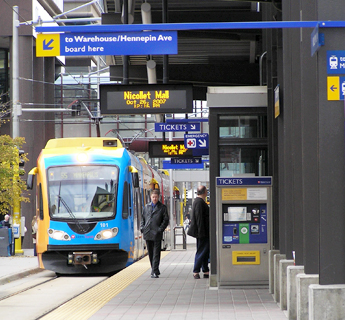Environmental Impacts of Transportation: Reduce the energy, carbon, and health impacts of transportation through reduced single-occupancy vehicle trips and phasing out of fossil fuel vehicles.

Minneapolis is uniquely positioned, along with Saint Paul, to lead the region in confronting the challenges of climate change and energy. The high concentration of people, buildings, and transportation networks create a centralized demand for fossil-fuel based energy. This intersection of people and infrastructure also creates a high level of vulnerability to the impacts of climate change, as warming temperatures, extreme weather events, and flooding can all threaten the reliability and security of the energy systems we depend on. Addressing the growing risks while reducing our impact on the climate will require unprecedented efforts to change our demands on the energy network and the way our energy system is structured.
The Minneapolis Climate Action Plan was adopted in 2013 and provides a road map toward reducing greenhouse gas emissions with targets of 15% by 2015 and 30% by 2025 from 2006 levels. In 2014, Minneapolis passed an 80% reduction goal by 2050 and formed the Clean Energy Partnership with Xcel Energy and CenterPoint Energy. In 2015, on-road transportation accounted for 26 percent of the city’s greenhouse gas emissions. Today, over 90 percent of passenger miles traveled in Minneapolis are in personal automobiles. Even with the adoption of electric cars, a 38 percent reduction in passenger miles traveled by automobile is needed to achieve the 80 percent reduction of greenhouse gas emissions by 2050.
In addition to impacting climate change, vehicle emissions significantly degrade air quality, especially for people living on or near busy streets and highways. These emissions lead to increases in asthma hospitalizations, cancer, and heart attacks.
A multi-pronged approach is necessary to substantially reduce vehicle emissions, including supporting environments that encourage walking as an attractive option, increased options for safe and comfortable bicycling, more reliable and attractive public transit, shared mobility options that support a car-free or car-lite lifestyle, and adoption of electric vehicles.
 ACTION STEPS
ACTION STEPS
The City will seek to accomplish the following action steps to reduce the energy, carbon, and health impacts of transportation through reduced single-occupancy vehicle trips and phasing out of fossil fuel vehicles.
- Require creation and implementation of travel demand management strategies in new development such as facilities for bicycle commuters, transit passes, and market-priced parking.
- Increase availability and attractiveness of public transportation and non-motorized modes, and continue to disincentivize driving and driving alone.
- Support the education and outreach efforts of transportation management organizations focused on reducing single-occupancy vehicle trips.
- Continue to evaluate and implement traffic control measures to minimize vehicle emissions.
- Implement fees and incentives that encourage the use of public transportation and zero-emissions vehicles in an equitable manner.
- Transition both public and private vehicle fleets to zero-emissions technology where technology allows.
- Explore incentives and requirements for electric vehicle charging infrastructure in new development and in the public right-of-way.
- Incorporate carbon-reduction design elements into City infrastructure projects.
- Enforce full compliance with the City’s idling ordinance. Utilize technology to track and improve compliance with the public fleet.
- Incentivize shared mobility options and maximize vehicle occupancy, ensuring the City is able to develop partnerships with public and private companies through policy and fee structures to support climate goals and equitable access to services.
- Document and publish the anticipated greenhouse gas impact of every major city infrastructure project.

